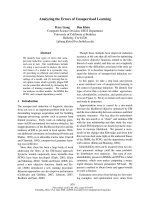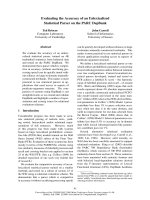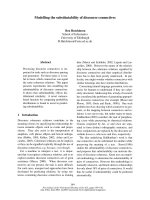Báo cáo khoa học: "Signalling the Interpretation of Indirect Speech Acts" pptx
Bạn đang xem bản rút gọn của tài liệu. Xem và tải ngay bản đầy đủ của tài liệu tại đây (176.95 KB, 2 trang )
Signalling the Interpretation of Indirect Speech Acts
Philip R. Cohen
Center for the Study of Reading
University of Illinois, &
Bolt, Beranek and Newman, Inc.
Cambridge, Mass.
This panel was asked to consider how various "problem
contexts" (e.g., cooperatively assembling a pump, or
Socratically teaching law) influence the use of language.
As a starting point, I shall regard the problem context
as establishing a set of expectations and assumptions
about the shared beliefs, goals, and social roles of
those participants. Just how people negotiate that they
are in a given problem context and what they know about
those contexts are interesting questions, but not ones I
shall address here. Rather, I shall outline a theory of
language use that is sensitive ¢o those beliefs, goals,
and expectations.
The theory is being applied to characterize actual
dialogues occurring in the Familiar task-orlented slt-
uation ~O.1, in which an expert instructs a novice Co do
something, in our case to assemble a toy water pump. In
such circumstances, the dialogue participants can be
viewed as performing speech acts planned, prlmarl]y, to
achieve goals set by the task. Other contexts undoubted-
ly emphasize the instrumental uses of language (e.g.,~)
but those problem contexts will not be considered here.
The application of a model of speech act use to actual
dialogue stresses the need For sources of evidence to
substantiate predictions. The purpose of this paper is
to point to one such source speaker-reference ~9]-
The natural candidate for a theory of instrumental use
of speech acts is an account of rational action ~
what is typically termed "planning". However, contrary
to the assumption of most planning systems, we are in-
terested in the planning of (usually) cooperative agents
who attempt to recognize and facilitate the plans of
their partners ~,h,5,]6,20]. Such helpful behavior is
independent of the use of language, but is the source of
much conversational coherence.
A plan based theory of speech acts specifies that plan
recognition is the basis for inferring the illocuCionary
force(s) of an utterance. The goal of such a theory is
to formalize the set of possible plans underlying the use
of particular speech acts Co achieve a given set of goals.
In light of the independent motivation for plan generation
and recognition, such a Formalism should treat commun-
icative and non-communlcatlve acts uniformly, by stating
the communicative nature of an illocutlonary act as part
of chat act's definition. A reasoning system, be it
human or computer, would then not have to employ special
knowledge about communicative acts; it would simply at-
tempt Co achieve or recognize goals.
The components of speech act p]annlng and recognition
systems developed so far include: a Formal language for
describing mental states and states of the physical and
social worlds, operators for describing changes of state,
associations of utterance features (e.g., mood) with cer-
taln operators, and a set of plan construction and re-
cognition inferences. Illocutionar'y acts are defined as
operators that primarily affect the mental states of
speakers and hearers L3,8,13,I7J.
To be more specific, in the most fully developed at-
tempt at such a theory, Perraulc and Allen ~ show how
plan recognition can "reason out" a class of indirect
speech acts. Briefly, they define "surface =' speech act
operators, which depend on an utterance's mood, and op-
erators For illocutionary acts such as requesting. Plan
recognition involves inferences of the form "the agent
intended to perform action X because he intended to ach-
ieve its effect in order to enable him to do some other
action Y". Such inferences are applied to surface speech
act operators (characterizing, for instance, "Is the salt
near you?") to yield iilocutionary operators such as
* For this brief paper, I shall have Co curtail discussion
of the planning/plan recognition literature.
requests to pass the salt.
The remainder of this paper attempts to illustrate the
kinds of predictlons made by the theory,.and the use of
anaphora to support one such prediction." Consider the
following dialogue fragment (transmitted over teletype)
in the water pump context described earlier:
Expert: l). '~e need a clear bent tube For the bottom
hole."
Novice: 2). "OK, it's done."
Expert: 3). "OK, now, start pumping"
The example is constructed to illustrate my point, but it
does not "feel" artificial. Experiments we are conducting
show analogous phenomena in telephone and teletype modes.
The theory predicts two inference paths For utterance
I "helpful" and "intended". In the Former case, the
novice observes the surface-lnform speech act indicated
by a declarative utterance, and interprets it simply as
an inform act that communicates a joint need. Then, be-
cause the novice is helpful, she continues to recognize
the plan behind the expert's utterance and attempts to
further it by performing the action of putting the spout
over the hole. The novice, therefore, is acting on her
own, evaluating the reasonableness of the plan inferred
for the expert using private beliefs about the expert's
beliefs and intentions. Alternatively, she could infer
that the expert intended for it to be mutually believed
that he intended her to put on the tube. Thus, the novice
would be acting because she thinks the expert intended
for her ¢o do so. Later, she could summarize the expert's
utterance and intentions as a request ~7]. Perrault and
Alien supply heuristics that would predlct-~" the preferred
inference route to be the "intended" path since it is
mutually believed that putting the tube on is the relev-
ant
act, and his intending that she perform pump-related
acts is an expected goal in this problem context. To use
Perrault and Alien's model For analyzing conversation,
such
predictions must be validated against evidence of
the novice's interpretation of the expert's intent.
Signalling Interpretation of Intent
For this problem context and communication modality,
the novice and expert shared knowledge that the exoert
will attempt to get the novice to achieve each subgoal
of the physical task, and the novice must indicate suc-
cessful completion of those subtasks. However, not all
communicative acts achieving the goal of indicating suc-
cessful completion provide evidence of the novice's in-
terpretation of intent. For instance, the novlce might
say "I've put the bent tube on" simply to keep the expert
informed of the situatlon. Such an informative act could
arise if the problem context and prior conversation dld
not make the salience of putting the tube on mutually
known. To supply evidence of the novice's interpretation
of intent, her response
must
pragmatically presuppose
that interpretation.
In our example, the novice has used "it" to refer to
the action she has performed. It has been proposed that
definite and pronomlnal/pro-verbal reference requires
mutual belief chat the object in question_ is in Focus
O0,,s]
and satisfies
the "descript,on'l t6,l . Assuming
that the,_inferring of mutually believed goals places them
in focusU~ , the shared knowledge needed to refer using
"it" is supplied by only one of the above interpretations
the one summarizable as an indirect request.
Robinson ~!~ has identified this problem of reference
to actions and has implemented a system to resolve them.
In chls paper, I stress the importance of that work to
theories of speech act use.
29
Other signals of the interpretation of intent need to
be identified to explain how the expertis "OK, now start
pumping" communicates that he thinks she has inter-
preted him correctly mutual signalling of intent
and its interpretation is central to conversational
Success.
A formal theory that could capture the belief, in-
tention, and focus conditions for speaker-reference is
thus clearly needed to validate models of speech act use.
A plan-based theory might accomodate such an analysis via
a decomposition of currently primitive surface speech
acts to include reference acts [2,18J. By planning ref-
erence acts to facilitate the hearers' plans (of. ~43),
a system could perhaps also answer questions coopera-
tively without resorting to Gricean maxims or "room
theories" [19.~.
I have given a bare bones outline of how a descrip-
tion of speaker-reference can ser~e as a source of em-
pirical support
to
a theory of speech acts. However,
much more research must take place to flesh
out
the
theoretical connections. I have also deliberately av-
oided problems of computation here, but hope the panel
will discuss these issues, especially the utility of
computational mode is to ethnographers of conversation.
Acknowledgements:
I would llke to thank Chip Bruce, Scott Fertig, and
Sharon 0vlatt
for
comments on an earlier draft.
References:
1. Allen, J. A plan-based approach to speech act ~eco~-
nitlon (Tech. Pep. No. 131/79). Toronto: Universi., or
Toronto, Department of Computer Science, January 1979o
2. Appelt, 0. Problem-solving applied
to
language gen-
eration. (This volume).
3- Bruce, B. Belief systems and language understandln~
(BBN
Report
NO. Z973). Cambridge, Hess.: Bolt, Beranek
and Newman, January 1975.
4. Bruce, B., & Newman, 0. Interacting plans. Cocjnl-
tire Science, 1978, ~, 195-233.
5. Carbonell, J. G. Jr. POLITICS: Automated ideologi-
cal reasoning. Co~nitlve Science, 1978, ~, 27-51.
6. Clark, N. H., & hsrshell, C. Oeflnite reference and
mutual knowledge. In A. K. Joshl, I. A. Sag, & B. L.
Webber (Eds.), Proceedings of the Workshop on Computa-
tional Aspects of Linguistic Structure and Discourse
Setting. Ne, York: Cambridge University Press, in press.
7. Cohen, P. R., & Levesque, H. L. Speech acts and the
recognition of shared plans. In Proceedlngs: Annual
meetin~ of the Canadian Societ~ for the Computational
Study of Intei, li~ence, Victoria, B.C., 19B0.
B. Cohen, P. R., & Perrauit, C. R. Elements of a plan-
based theory of speech acts. Co~nittve Science, 1979, ~,
177-212.
9. Donnell4m, K. Speaker references, descriptions, and
anaphora. In P. Cole (Ed.), Syntax and semantics (Vol.
~): Pra~matics. New York: Academic Press,
1978.
10. Grosz, B. The representation and use of focus in
dialo~ue understandin~ (Technical Note 151). Reflio Park,
Calif.: Stanford Research Institute, Artificial Intelli-
gence Center, July
1977.
I1. Hobbs, J. R., 8 Evans, D. E. Conversation as planned
behavior (Technical Note 203). ~enlo Park, Callf.:
Stanford Research Institute, Artificial Intelligence
Center, 1979.
12. Norgan, J. L. Toward a rational model of discourse
comrehension, in O. Waltz (Ed.), Proceedings: Theoret-
cal Issues in Natural Language Understandinq. Urbane:
University of Illinois, Coordinated Science Laboratory,
1978.
13. Perrault, C. R., & Allen, J. F. A plan-based anal-
ysis of indirect speech acts. In submission.
14. Perrauit, C. R., & Cohen P.R. Inaccurate refer-
ence. In A. K. Joshi, I. A. t jg, & B. L. Webber (Eds.),
Proceedings of the Workshop on Computational Aspects of
Linguistic Structure and 0iscourse Setting. New York:
Cambridge University Press, in press.
15. Robinson, A. E. The interpretation of verb ~hrases
in dialo9s (Technical Note 206). Henio Park, Calif.:
Stanford Research Institute, Artificial Intelligence
Center, 1980.
16. Schank, R., S Abe lson, R. Scripts, plans r ~oals,
and understandln~. Hillsdale, N.J.: Erlbaum, 1977.
17. Solidi, C. F. Understanding human action, in
Proceedings of the conference on Theoretical Issues in
Natural Language Processing. Cambridge, ~ass., 1975.
18. Seerte, J. R. Speech acts: An essay in the philos-
ophy of language. Cambridge: Cambridge University
Press, 1969.
19. Shannon, B. ~/here-questions. In Proceedings of the
Seventeenth Annual P~etin~ of the ACL, San Diego, 1979.
Pp. 73-75.
20. Wllensky, R. Understandin~ 9De i-based stories
(Research Rap. No. 140). New Haven, Conn.: Yale Univer-
sity, 0apartment of Computer Science, September 1978.
30









